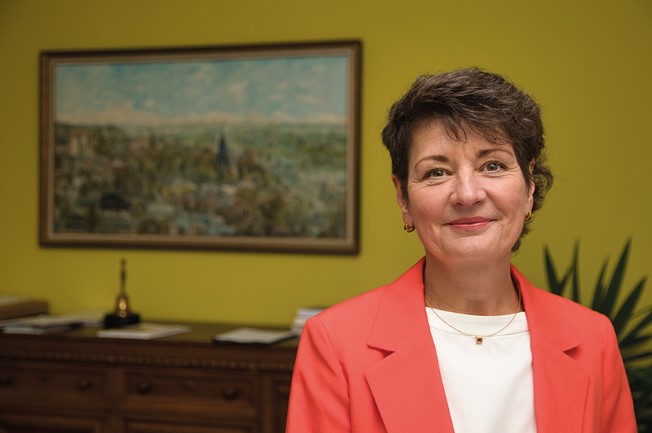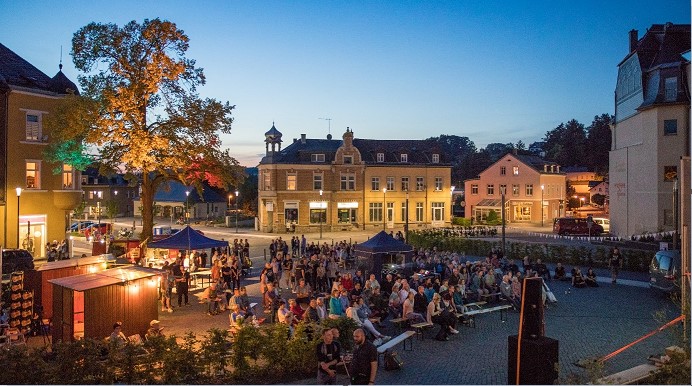The small town of Rodewisch is located in Saxony, Germany and has 6,500 inhabitants. It is part of the association of local authorities in the Göltzsch Valley which cooperates according to the credo “Plan and act as if municipal boundaries did not exist”. Local measures are based on the guiding principles of the regional development concept and thus have an impact beyond the municipality.
With two hospitals and a grammar school, Rodewisch’s municipal services of general interest are good compared to the population. However, a decline in the birth rate and the departure of young people after reunification have accelerated the demographic change though – not only in the municipality, but in the entire region. The municipality aims to make the region more attractive again, especially for the younger generation. In doing so, it wants to create sustainable future prospects. One project, for example, is the upgrading of central public spaces into places that meet the needs of children, parents and young people.
Sina Redlich, policy officer at the Federal Institute for Research on Building, Urban Affairs and Spatial Development Germany (BBSR) talked with Mayor Kerstin Schöniger about current challenges of small towns and her views on the Territorial Agenda.
Sina Redlich: Rodewisch focuses on being attractive to young people and families. Many small towns in Europe take up this challenge. However, the eastern German states stand out in Europe due to their particularly old population. Do the measures carried out in Rodewisch have an effect?
Kerstin Schöniger: Yes and no. There are rays of hope: Young families, who have their roots in the region, like to return to the region, especially after having started a family, and I am happy about every single one! Net migration is positive but: The number of inward migrants is not yet sufficient to significantly reduce the average age of the population and to keep the population stable. The number of deaths therefore still exceeds the number of births.
Last year, more than 200 people from Ukraine settled in Rodewisch due to the war, mainly women and children. This has increased our population – but I don’t know for how long. Our maxim is here: Every person who wants to stay is welcome and gets our support and those who go back home, might remember the good times in Rodewisch.
The ministers for spatial development in Europe have adopted the Territorial Agenda 2030 with the motto “A future for all places”. With the Territorial Agenda, the different potentials and challenges for different areas, small towns and large cities and regions, are recognised. What do you think such a European strategy document can achieve?
The Territorial Agenda 2030 is a pan-European political statement in favour of structurally weak areas including small towns in eastern Germany such as Rodewisch. The document must now be filled with life, also by me as the mayor of a small town. In addition, many other committed actors are required. The information must be exchanged vertically, and horizontally we are called upon to cooperate intensively on an intermunicipal level.
Specifically, I will make use of the targeted national funding we receive, even though I know that the related bureaucratic effort is not small. In addition, I will devote a lot of energy to intensifying intermunicipal cooperation. And – very importantly – get the opinion, wishes and criticism of the local people in order to pass them on vertically. Hence, such a document can only have an impact if those, who are addressed, internalise it. And that’s what we do.
 Large cities and small towns, which cooperate with their surrounding areas, can serve as an engine for regional growth according to the Territorial Agenda 2030. Rodewisch is part of the association of local authorities in the Göltzsch Valley. What are the advantages of this cooperation for you?
Large cities and small towns, which cooperate with their surrounding areas, can serve as an engine for regional growth according to the Territorial Agenda 2030. Rodewisch is part of the association of local authorities in the Göltzsch Valley. What are the advantages of this cooperation for you?
Apart from Rodewisch, the small municipalities of Auerbach, Ellefeld and Falkenstein belong to the association. From the point of view of spatial planning, we altogether form a middle-order centre with about 35,000 inhabitants. Geographically as well, we are closely connected. Cooperation is therefore almost inevitable and has enormous potential. Future tasks of municipalities – such as digitalisation, climate adaptation, climate neutrality, mobility, the lack of a workforce, migration and much more – require larger structures and regions.
Of course, this is also about money. Our municipalities shrink and with them the free funds. In order to be able to offer local people sports, education and culture as usual, we must join forces and are encouraged to form an alliance for the benefit of the people of the Göltzsch Valley. This is the guiding principle of my role as spokeswoman of the association.
What challenges do you face in the context of intermunicipal cooperation? And what would you advise other small towns to initiate such cooperation?
Intermunicipal cooperation, of course, depends on the will and mutual sympathy of the people involved. In this respect, it is in my opinion good to begin with small, visible steps. This may lead to greater things. You also need to be aware that you need patience. Processes must be agreed and decided upon in the committees, sometimes they must be readjusted. Defeats should not lead to resignation. It is also very important to act at eye level and to appoint project managers.
According to the Territorial Agenda 2030, education, digital skills and broadband access are important factors for increasing spatial inequalities. Older people and people living in remote or rural areas often run the risk of being excluded from the digital transformation. What exactly do you do about it in Rodewisch?
I cannot confirm for our regions that people, not either older people, lag behind digital transformation. On the contrary: digitisation offers the people here an opportunity. It enables participation and equal living conditions, possibly in a different, but accepted way. It facilitates and enriches everyday life. There are chat groups of senior citizens, which our senior representative has initiated and in which the exchange works wonderfully. When the technology doesn’t function, people help each other. The Vogtland app is not only a tourist offer, the local people also like to use it. Home office is also possible in rural areas and our schools are fully digitised. Together with the vocational school centre in Rodewisch, the initiative “senior citizens to the web” was initiated, which, in the meantime, has resulted in partnerships from young for old people. All this shows: digitalisation is a large chance for rural areas. We perceive it as such and actively promote it.
In 2018 you said “If things run as scheduled, every local household will be connected to the fibre optics network in 2021.” Did things run as scheduled?
They did! It was a tour de force coordinated by the Vogtlandkreis county authority for which we are very grateful. We are also grateful that the state of Saxony has taken over the municipal contributions for the development. Our schools and the town hall use the network in the same way as business and commerce and private households. It’s a pleasure when sound and image work perfectly during video conferences and when modern teaching formats don’t fail because the Internet is too slow.
Do changes in the world of work, like the possibility of getting more done from the home office, offer opportunities to attract more young people to Rodewisch?
Creating infrastructure is a very important start, but only a beginning. Now it is up to many people to generate added value for the region. Employers must allow working from home regardless of the pandemic. Naturally this is particularly interesting for young people. It makes a difference whether you have to travel to work five times or maybe only two or three times a week. This opens up a completely different radius when looking for a job. We take up this change in the world of work and are currently working on a project on co-working spaces within the intermunicipal association. We examine in two locations – one in a former hospital in Falkenstein and one in the inner city of Auerbach – whether there is a need for joint working far from the actual place of performance. I am very curious! So yes, I hope for young families who want to live in the Göltzsch Valley under these conditions.
The inner city of Rodewisch combines multifunctional uses: living, groceries, doctors, gastronomy, retail trade – combined with an amenity quality in public space. Can Rodewisch be a model for larger cities which increasingly have to put up with the fact that shopping as the only function of the inner city is no longer sufficient?
With the pandemic at the latest, the responsible persons in large cities and small towns have realised that retail trade is not the “cure-all” for intact inner cities. An attractive retail trade, of course, belongs in every city, but also some more for a city to be resilient. The challenge is to find a multifunctional use and a characteristic profile for one’s city. An attractive inner city that invites you to stay is a hard criterion largely supported by the city administrations. This is where retail trade, housing, services, medical care, gastronomy, culture and non-disruptive trade should join. We want to add a day nursery to the whole thing. A local public transport connection is natural.
Everything that brings people together is welcome. There is no universally applicable manual for organising inner cities, which is why especially individuality and creativity are in demand – correctly handled a big chance!
I am very happy that the Federal Government programme Sustainable Inner Cities and City Centres enables us to actively manage the inner city. Its agenda includes regular owner meetings, networking activities, preparing the purchase of real estate, shaping open spaces according to the wishes of citizens, pop-up actions, celebrations and much more. Whether they are successful or not, we must try and find formats that meet the zeitgeist. For that as well we need the local people, their ideas and desires.
A small town academy to promote cooperation, advice and networking on urban development issues in smaller towns and municipalities in Germany was piloted. The related advisory board, to which you belong, plays an important role. It is composed of decision-makers from the scientific, political, university and administrative sectors, from professional associations and networks. What personal impression do you gain from your work in the advisory board? Are the real needs of small towns heard?
To paraphrase my esteemed colleague on the advisory board, Tanja Rönck, mayor of Malente: There are tower clocks and pocket watches, both of them show the time. However, one would never come up with the idea of repairing both with the same tool.
We want to fill the tool box for small towns. Through experimental urban development projects in the same way as through networking with each other and with politics. We also want to analyse failure and pass on knowledge. We want to be the voice of small towns. The broad professional structure of the advisory board guarantees that problems are viewed from different perspectives and thus are heard.
This article is an excerpt of an interview that was first published in the BBSR journal “IzR – Informationen zur Raumentwicklung” 1/2023. Translation: Beatrix Thul, BBSR. Credits of Rodewisch town picture: © Matthias Ditscherlein; credits of Kertstin Schöniger: © Kerstin Schöniger.


